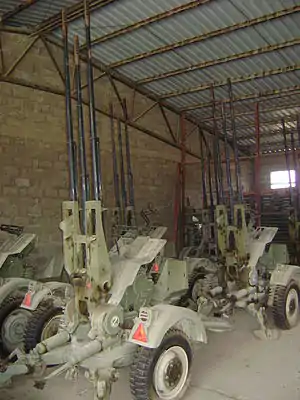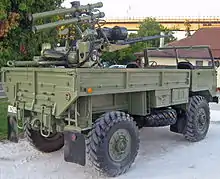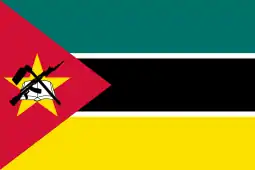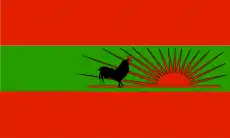Zastava M55
The Zastava M55, also designated 20/3-mm-M55, is a Yugoslavian/Serbian 20mm triple-barreled automatic anti-aircraft gun developed in 1955 and produced by Crvena Zastava (now Zastava Arms company) in Kragujevac, Serbia, for Yugoslav People's Army use and also for the export market. In addition to the basic towed model M55 A2, the variants M55 A3 B1, M55 A4 B1 and the BOV-3 SPAAG were also developed.
| Zastava M55 | |
|---|---|
 M55 A4 B1 guns of the former Army of Republika Srpska | |
| Type | Towed 20 mm Anti-Aircraft Triple Autocannon |
| Place of origin | Yugoslavia/Serbia |
| Service history | |
| In service | 1955–present |
| Used by | See Operators |
| Wars | Angolan Civil War South African Border War Rhodesian Bush War Mozambican Civil War Lebanese Civil War Salvadoran Civil War Yugoslav Wars |
| Production history | |
| Designer | Zastava Arms |
| Designed | 1955 – 1971 |
| Manufacturer | Zastava Arms |
| Produced | 1971 – still in production |
| Variants | See Variants section |
| Specifications (Zastava M55) | |
| Mass | 1,100 kg loaded, 970 kg unloaded |
| Length | 1.47 m (driving condition) |
| Barrel length | 1.956 mm |
| Width | 1.27 m (driving condition) |
| Height | 4.30 m (driving condition) |
| Crew | 6 -- gunners and commander |
| Shell | 20x110mm Hispano |
| Caliber | 20 mm |
| Barrels | 3 |
| Action | Gas operated |
| Traverse | 360° |
| Rate of fire | 1,950 and 2,250 rpm cyclic, 700 rpm practical |
| Effective firing range | 4,000 m (vertical), 5,500 m (horizontal) |
| Feed system | 3 x 60 round top-fed drum magazines |
Development
In 1951, the Federal Secretariat of People's Defense (Serbo-Croatian: Savezni sekretarijat za narodnu odbranu – SSNO) purchased the manufacturing licence of the single-barrel Hispano-Suiza HS.804 20mm L/70 anti-aircraft autocannon mounted on the HSS.630-3 towed gun carriage. The HS.804 entered production by the Crvena Zastava Company in 1955 as the Zastava 20/1mm M55 and the Company's engineers began working in the development of a triple-barrelled version. In 1971 the first prototype of the triple-barrelled Zastava 20/3mm M55 was completed, which entered production that same year.[1][2]
Variants
Ground model M55 A2

The standard towed version of the M55 introduced in 1971, is intended for infantry use.[3] The M55 A2 consists of three license-produced, 1.956 mm-long barreled Hispano-Suiza HS.804 20 mm L/70 cannons held in place on a single electronically-powered HSS.630-3 mount and towed carriage for transport. In the driving state, the length is 4.30 m, the width is 1.27 m and the height is 1.47 m. The guns are placed close together to allow quicker reloading and the middle barrel is offset backwards in the horizontal position. The ammunition feed is carried out for each barrel by means of a top-fed 60-round drum magazine. The gun is placed on three foldable feet for use and the wheels are folded up, but it can be fired mounted on the wheeled carriage in an emergency. The suspension is spring-loaded and hydraulically-raised. With the gun, it can be driven to a top speed of 80 km/h; a TAM-110 (4x4) military transport truck is used as a towing vehicle. The total weight, including ammunition is 1,100 kg and without ammunition is 970 kg.
The gunner sits at the rear end of the gun and adjusts the traverse (360°) and elevation (+83° to -5°) with two handrails. It is fired with a pedal. In the M55 A2 B1 improved version introduced in 1975, an automatic optical-mechanical visor (PANS-20/3) is available to the gunner for better target acquisition. The gunner receives various data when the target is detected and the target is advanced; therefore, it is not necessary to keep on firing. With this optics, however, only subsonic aircraft can be engaged. Targets with speeds up to 1,000 km/h can be engaged at a distance of 1,500 m and slower targets up to a distance of 2,000 m. The maximum range for airspace defense is 4,000 m. A theoretical cadence of 700 rounds per minute is possible per tube, although it is able to fire all three guns simultaneously, allowing an impressive rate of fire between 1,950 and 2,250 rounds per minute, which however, cannot be achieved practically due to the reloading times.
In addition to the anti-aircraft role, the Zastava M55 was also used extensively in the direct fire support role, being often mounted on trucks. The operational firing range against ground targets is 2,500 m, the maximum range is 5,500 m.
M55 A3 B1
This is an improved version of the M55 A2 introduced in 1978.[4] The main difference to the basic model is the hydraulic directional drive of the gun, which is driven by a small gasoline wankel engine to the right of the gunner's seat to provide power and relieve the gunner of having to manually control the traverse and elevation. The engine has an 8 HP performance and 160 cm³, which provides 5.22 kW. With this system a faster judging is possible, the operation is effected by means of a joystick. Total weight is thus increased to 1,235.5 kg with ammunition and 1,150 kg without ammunition. However, the barrels, the mount and the aiming device are identical to the basic model.
M55 A4 B1
Also introduced in 1977-78, this is an M55 gun system mounted on the towed carriage of the Swiss GAI-D01 anti-aircraft gun. On the A4 B1 a new computer-controlled targeting system – the Galileo ballistic computer – was installed, which automatically monitors the gun after the target has been acquired. In addition, an engine of the same type as the M55 A3 B1 has been placed under the gunner's seat, which was moved from the lateral position found on the previous version in order to improve the weight distribution of the three barrels and prevent them from vibrating. When the cannon is put into position, the towed carriage is removed, and a small splinter-proof shield has been installed in front of the targeting device and the gunner.[5]
Ammunition
- 20 × 110 mm PZ (pancirno zrno) M60 armour-piercing grenade pointer/marker (with and without flow clearing device): Deep black paint with earth-red ring in the upper third of the grenade. The granulated shell consists of hardened steel and absorbs the phosphorus firing in the rear, which ignites when hitting a target.
- 20 × 110 mm TZO (trenutno zapaljivo obilježavajuće) M57 explosive torch cartridge with illuminator: Chrome-yellow paint with earth-red ring in the upper third of the grenades and a green ring above the guide ring. The grenade is made of steel and has a Trotile explosive filling inside the center, which ignites when a target is hit. The sensitive AZZ UT M57 headlamp screwed onto the grenade is an explosive impact fuse with a self-disengaging device which starts after 4.5 to 9.5 seconds.
- 20 × 110 mm TZ (trenutno zapaljivo) M57 explosive torch cartridge without illuminator.
- 20 × 110 mm M79 exercise carousel (with glow track): Dark green paint with light green ring above the guide ring. Steel case with impact lighter, which, when striking a target, ignites a lightning bolt to allow a better observation of the hit image.
- 20 × 110 mm M77 exercise cartridges: cream white. A plastic floor filled with iron powder and provided with breakpoints, which bursts after exiting the barrel.
Combat history
Africa
The Zastava M55 A2 was employed extensively by the People's Armed Forces of Liberation of Angola (FAPLA) during the Angolan Civil War (1975-2002) and the later stages of the South African Border War (1966-1990), with a number of them being captured by the South African Defence Force (SADF) during their military operations launched against SWAPO/PLAN guerrilla bases at southern Angola in the 1980s.[10] Some of the captured guns were subsequently stripped from the triple mounts and re-mounted on the Casspir APCs employed by the Koevoet on their counter-insurgency operations in Angola and South West Africa[11] whilst others were handed over to the Armed Forces of Liberation of Angola (FALA), the armed wing of UNITA.
The Zastava M55 was also employed by the People's Forces of Liberation of Mozambique (FPLM) during both the Mozambican Civil War (1977-1992) and the later phase of the Rhodesian Bush War, with a few guns falling into the hands of the Rhodesian Security Forces in the course of their covert cross-border raids ('externals') on Zimbabwe African National Liberation Army (ZANLA) guerrilla training camps in Mozambique during the late 1970s.[12]
Middle East
Lebanon received from Yugoslavia an unspecified number of Zastava M55 A2 autocannons sometime in the early 1970s, which were assigned to the air defense units of the Lebanese Army and the Lebanese Air Force.[13] These were extensively employed during the Lebanese Civil War (1975-1990), with several guns falling into the hands of the various competing Christian and Muslim militias after the collapse of the Lebanese Armed Forces (LAF) in January 1976. Main operators included the Army of Free Lebanon (AFL), Lebanese Arab Army (LAA),[14] Al-Tanzim, Kataeb Regulatory Forces (KRF),[15] Zgharta Liberation Army (ZLA), the Tigers Militia, the Druze People's Liberation Army (PLA)[16][17] and the Al-Mourabitoun,[18][19][20] who mounted their Zastava M55 autocannons on technicals and M113 armored personnel carriers.[21][22][23][24]
Yugoslav Wars
During the breakup of Yugoslavia and the subsequent Yugoslav Wars that erupted in the 1990s, both the Zastava M55 towed versions and the BOV-3 SPAAG were employed extensively in the Ten Day War in Slovenia, the Croatian War of Independence, the Bosnian War and the Croat-Bosniak War by nearly all the warring factions. These included the Yugoslav People's Army, the Army of the Republic of Serb Krajina and the Army of Republika Srpska on one side, and their adversaries of the Slovenian Territorial Defence, the Croatian National Guard, the Croatian Defence Council and the Army of the Republic of Bosnia and Herzegovina on the other.
2020 Nagorno-Karabakh War
Azerbaijan's Ministry of Defence reported that it had destroyed two Armenian Zastava M55s between the 9th and 10th of October 2020 as part of the 2020 Nagorno-Karabakh war.[25]
Operators
 Armenian Armed Forces[26]
Armenian Armed Forces[26] Angolan Armed Forces[27][28]
Angolan Armed Forces[27][28] Armed Forces of Bosnia and Herzegovina[29]
Armed Forces of Bosnia and Herzegovina[29] Armed Forces of the Democratic Republic of the Congo[30]
Armed Forces of the Democratic Republic of the Congo[30] Army of the Republic of North Macedonia[31]
Army of the Republic of North Macedonia[31] Croatian Army
Croatian Army Guatemalan Armed Forces
Guatemalan Armed Forces Mozambique Defence Armed Forces
Mozambique Defence Armed Forces Salvadoran Army[32]
Salvadoran Army[32] Serbian Army
Serbian Army Slovenian Armed Forces
Slovenian Armed Forces Tunisian Army[33]
Tunisian Army[33]
Former operators
 Armed Forces of Liberation of Angola (UNITA) – Handed over by South Africa or captured from FAPLA.
Armed Forces of Liberation of Angola (UNITA) – Handed over by South Africa or captured from FAPLA. Lebanese Armed Forces – Retired (now used for training purposes only).
Lebanese Armed Forces – Retired (now used for training purposes only)..svg.png.webp) Rhodesian Security Forces – Captured from FPLM or ZANLA.
Rhodesian Security Forces – Captured from FPLM or ZANLA..svg.png.webp) South African Defence Force – Captured from FAPLA.
South African Defence Force – Captured from FAPLA. Syrian Armed Forces
Syrian Armed Forces.svg.png.webp) Yugoslav People's Army and Territorial Defense – passed on to successor states.
Yugoslav People's Army and Territorial Defense – passed on to successor states. Indonesian Air Force Paskhas corps, 55 M55 A2 units.
Indonesian Air Force Paskhas corps, 55 M55 A2 units.
See also
- Hispano-Suiza HS.404
- Hispano-Suiza HS.661
- Hispano-Suiza HS.804
- Hispano-Suiza HS.820
- Oerlikon 20 mm cannon
- Zastava Arms
- ZPU
- ZU-23-2
Notes
- Jandrić, Seventh Decade of the Military Technical Institute (1948. – 2013.), p. 9.
- "1945 – 1970 | Zastava-arms". www.zastava-arms.rs. Retrieved 2017-07-13.
- "1970-1992 | Zastava-arms". www.zastava-arms.rs. Retrieved 2017-07-13.
- "1970-1992 | Zastava-arms". www.zastava-arms.rs. Retrieved 2017-07-13.
- "1970-1992 | Zastava-arms". www.zastava-arms.rs. Retrieved 2017-07-13.
- "1970-1992 | Zastava-arms". www.zastava-arms.rs. Retrieved 2017-07-13.
- Jandrić, Seventh Decade of the Military Technical Institute (1948. – 2013.), p. 9.
- "1945 – 1970 | Zastava-arms". www.zastava-arms.rs. Retrieved 2017-07-13.
- Christopher F. Foss, Jane's Tank & Combat Vehicle recognition guide (2002), pp. 298-299.
- Venter, War in Angola (1992), pp. 7; 9.
- Heitman & Hannon, Modern African Wars (3): South-West Africa (1991), p. 22.
- Photos of Zastava M55 autocannons captured by the Rhodesian Security Forces in Mozambique, September 1979.
- Kassis, Véhicules Militaires au Liban/Military Vehicles in Lebanon (2012), p. 15.
- Lebanese Arab Army M113 APCs with ZU-23-2 and Zastava M55 autocannons
- Kassis, 30 Years of Military Vehicles in Lebanon (2003), p. 27.
- Neville, Technicals: Non-Standard Tactical Vehicles from the Great Toyota War to modern Special Forces (2018), p. 15.
- Kassis, Invasion of Lebanon 1982 (2019), p. 233.
- Kassis, 30 Years of Military Vehicles in Lebanon (2003), p. 66.
- El-Assad, Civil Wars Volume 1: The Gun Trucks (2008), p. 93.
- Zastava M55 autocannon of the Al-Mourabitoun militia in the Lebanese civil war
- Jureidini, McLaurin, and Price, Military operations in selected Lebanese built-up areas (1979), appendix A, table A-6.
- Kassis, 30 Years of Military Vehicles in Lebanon (2003), p. 27.
- El-Assad, Civil Wars Volume 1: The Gun Trucks (2008), p. 93.
- Kassis, Véhicules Militaires au Liban/Military Vehicles in Lebanon (2012), p. 53.
- https://tass.com/world/1210743
- https://tass.com/world/1210743
- "Angolan Army Equipment". Globalsecurity.org.
- "Angolan army land ground forces military equipment armoured vehicle pictures information desc - Army Recognition".
- "Bosnia Herzegovina Land Forces military equipment, armament and vehicles Army" armyrecognition.com
- Wondo Omanyundu, Jean-Jacques (23 May 2018). "Joseph Kabila continues to over-equip his regime militarily for the upcoming political deadlines". desc-wondo.org.
- Army of the Republic of Macedonia official site
- "El Salvadoran Army index equipment" armyrecognition.com
- Tunisian Army modified GMC M35 Trucks with Zastava M55 Triple 20 mm Anti-Aircraft Autocannons.
References
- Al J. Venter, War in Angola (1030), Concord Publications, Hong Kong 1992. ISBN 962-361-030-0
- Christopher F. Foss, Jane's Tank & Combat Vehicle recognition guide, HarperCollins Publishers, London 2002. ISBN 0-00-712759-6
- Helmoed-Romer Heitman & Paul Hannon, Modern African Wars (3): South-West Africa, Men-at-arms series 242, Osprey Publishing Ltd, London 1991. ISBN 9781855321229
- Samer Kassis, 30 Years of Military Vehicles in Lebanon, Beirut: Elite Group, 2003. ISBN 9953-0-0705-5
- Samer Kassis, Véhicules Militaires au Liban/Military Vehicles in Lebanon 1975-1981, Trebia Publishing, Chyah 2012. ISBN 978-9953-0-2372-4
- Samer Kassis, Invasion of Lebanon 1982, Abteilung 502, 2019. ISBN 978-84-120935-1-3
- Leigh Neville, Technicals: Non-Standard Tactical Vehicles from the Great Toyota War to modern Special Forces, New Vanguard series 257, Osprey Publishing Ltd, Oxford 2018. ISBN 9781472822512
- Miroslav Jandrić, Seventh Decade of the Military Technical Institute (1948. – 2013.), Scientific Technical Review, 2013, Vol. 63, No. 2, pp. 5–25. UDK: 355.014:623.4, COSATI: 15-05, 19-06, 01-03 –
- Moustafa El-Assad, Civil Wars Volume 1: The Gun Trucks, Blue Steel books, Sidon 2008. ISBN 9789953012568
- Paul Jureidini, R. D. McLaurin, and James Price, Military operations in selected Lebanese built-up areas, 1975-1978, Aberdeen, MD: U.S. Army Human Engineering Laboratory, Aberdeen Proving Ground, Technical Memorandum 11-79, June 1979.
